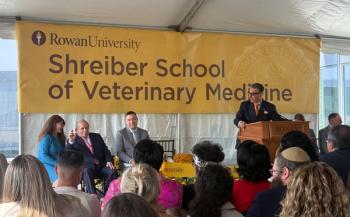
Get defensive when working with equine veterinary patients
Dr. Robert Miller says when it comes to working with horses, every offense you commit from a horse's point of view needs a preplanned defense on your part.
"Maybe I should of thought ahead about this ..." (Shutterstock)At the CVC in Kansas City-
During his presentation on safe horse handling, Dr. Miller recounted the sad tales of veterinarians and horse owners who meant to do the right thing yet faced tragic ends. Dr. Miller has lost two colleagues because of working with horses-one was floating a horse's teeth and was struck in the chest, which hemorrhaged her pericardial sac. In fact, Dr. Miller himself was once hospitalized after a 3-month-old colt ran into him full speed when he was trying to rope the colt and it got scared. “I always wondered what it would feel like to be hit by a 300-lb football lineman-I found out,” he said. This incident resulted in a ruptured cruciate ligament. Hear the whole story from Dr. Miller in the audio clip below:
Several years ago Dr. Miller was approached about making a video on safer horsemanship, which he prefers to call “defensive horsemanship”-just like when you're driving a car, always prepare for the worst to happen. After seeing some equine practitioners and owners handle horses in what he considered a potentially dangerous manner, he decided it was a good idea.
The serendipity of loose boots
Dr. Miller's dad once gave him a pair of Western boots that were too big for him. They were hard to walk in, but he didn't want to hurt his dad's feelings so decided he could ride horses with them. This turned out to be a fortuitous turn of events.
At one point when Dr. Miller was roping calves with these overly large boots on, he was dismounting after he thought he had successfully roped a calf, and his foot caught in the stirrup. The calf bolted off, upsetting the horse. The next thing Dr. Miller knew he was down on the ground going around the arena at 40 mph.
Luckily, the ground was soft and his boot quickly fell off, saving him from prolonged dragging. “I learned my lesson. Don't wear tight boots,” says Dr. Miller. In fact, he recommends getting boots that are one size too large for riding. He has heard from at least two people that this bit of advice saved their lives.
Start with the right approach
Dr. Miller says the safest place to stand by a horse is the shoulder; he always starts there. “You never know when they're going to misinterpret who you are or what your intentions are,” he says. “Everything a veterinarian does to a horse either frightens them or hurts them.” This results in their flight or fight mechanism kicking in, and most horses go right to flight.
He tries to find three points of contact when working on any area of a horse, since a triangle is a strong physical defense. For example, you can brace your body against the side of the horse, slide your foot out as a second base, and place your nondominant hand firmly near the area in which you are working.
A lesson in temperature taking
One example Dr. Miller discussed was how he takes a horse's temperature, which can be a sensitive issue for our equine friends to be sure. Dr. Miller says to stand to the side of the horse and lock your hip against the horse's stifle. Then you can pick up the tail, and he recommends desensitizing the anus by lightly touching around the area so they know what you're going to do. Finally, place the thermometer and don't push it but rotate it, which makes the sphincter automatically open and lets the thermometer go right on in.
At this point, since you are to the side of the horse, if the horse kicks back, you're not on the receiving end. And if it kicks forward, as Dr. Miller says you'll remember from vet school, the hock and stifle can't operate independently-they flex together. If the horse does kick forward, because you're by the stifle it may push you forward, but you're safe.
Dr. Miller talks with CVC Kansas City attendees during a break in the exhibit hall. (Photo by Mindy Valcarcel)Parting advice
What if a client insists that their horse is gentle? “Never assume a horse is safe,” says Dr. Miller. A friend of Dr. Miller's who is a human emergency doctor told him most injuries he had seen caused by horses were from horses considered gentle. In addition, most injuries occurred when people were on the ground, not when they were riding.
So don't be afraid to defend your defensiveness. “If somebody thinks you're being overly cautious, that's fine. At least you'll be alive to contradict them,” says Dr. Miller.
Newsletter
From exam room tips to practice management insights, get trusted veterinary news delivered straight to your inbox—subscribe to dvm360.






